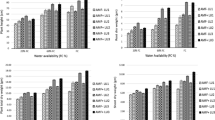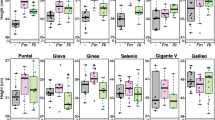Abstract
We examined the effect of arbuscular mycorrhizal fungi inoculation at the nursery stage on the growth and nutrient acquisition of wetland rice (t Oryza sativa L.) under field and pot conditions. Seedlings were grown on γ-ray sterilized paddy soil in two types of nurseries, namely dry nursery and wet nursery, with or without arbuscular mycorrhizal fungi (AMF) inoculation which was a mixture of indigenous AMF (t Glomus spp.) spores collected from the paddy field. Five-to-six week old seedlings were transplanted to the unsterilized soil under field and pot, respectively. Mycorrhizal seedlings had higher shoot biomass under both nursery conditions 5 weeks after sowing. Mycorrhizal colonization and sporulation were 2 to 3 times higher in the dry nursery than the wet nursery at the transplanting stage. Mycorrhizal colonization of plants inoculated in the nursery remained higher than those not inoculated under both field and pot conditions. Sporulation after transplanting to field conditions was about 10 times higher than in the pot. Inoculated plants produced higher biomass at maturity under field conditions, and the grain yield was 14-21% higher than those not inoculated. Conversely, grain yield and shoot biomass were not significantly influenced by AMF colonization under pot conditions. For plants originating from the dry nursery, N, P, Zn and Cu concentrations of field-grown plants at harvest were significantly increased by preinoculation with AMF over those left uninoculated. We conclude that the AMF inoculation at the nursery stage under both dry and wet conditions increased growth, grain yield and nutrient acquisition of wetland rice under field conditions.
Similar content being viewed by others
References
Bagyaraj D J, Manjunath A and Patil R B 1979 Occurrence of vesicular-arbuscular mycorrhizas in some tropial aquatic plants. Trans. Br. Mycol. Soc. 73, 164-166.
Beyrle H 1995 The role of phytohormones in the function and biology of mycorrhizas. InMycorrhiza. Eds. A Varma and B Hock. pp 365-390. Springer-Verlag, Berlin.
Chaubal R, Sharma G D and Mishra R R 1982 Vesicular-arbuscular mycorrhiza in subtropical aquatic and marshy plant communities. Proc. Indian Acad. Sci. 91, 69-77.
Clayton J S and Bagyaraj DJ 1984 Vesicular-arbuscular mycorrhizas in submerged aquatic plants to New Zealand. Aquat. Bot. 19, 251-262.
Daniels B A and Skipper H D 1984 Methods for the recovery and quantitative estimation of propagules in soil. InMethods and Principles of Mycorrhizal Research. Ed. N C Schenck. pp 29- 35. The American Phytopathological Society, St. Paul, MN.
Dhillion S S and Ampornpan L A 1992 The influence of inorganic nutrient fertilization on the growth, nutrient composition and vesicular-arbuscular mycorrhizal colonization of pretransplant rice (Oryza sativaL.) plants. Biol. Fertil. Soils 13, 85-91.
Douds D D and Schenck N C 1990 Relationship of colonization and sporulation by VA mycorrhizal fungi to plant nutrition and carbohydrate contents. New Phytol. 116, 621-627.
Giovannetti M and Mosse B 1980 An evaluation of techniques for measuring vesicular-arbuscular mycorrhizal infection in roots. New Phytol. 84, 489-500.
Gupta N and Ali S S 1993 VAM inoculation for wetland rice. Mycorrhiza News 5, 5-6.
Horiguchi T 1995 Rhizosphere and root oxidative activity. InScience of the Rice Plant. Vol. 2. Physiology. Eds. T Matsuo, K Kumazawa, R Ishii, K Ishihara and H Hirata. pp 221-243. Nobunkyo, Tokyo.
Jeffries P 1987 Use ofmycorrhizae in agriculture. Crit. Rev. Biotechnol. 5, 319-357.
Keeley J E 1980 Endomycorrhizae influence growth of blackgum seedlings in flooded soils. Am. J. Bot. 67, 6-9.
Keeney D R and Nelson D W 1982 Nitrogen-inorganic forms. InMethods of Soil Analysis. Part 2. Chemical andMicrobiological Properties. Eds. A L Page, R HMiller and D R Keeney. pp 643- 698. ASA-SSSA, Inc., Madison, WI.
Kormanik P P and McGraw A-C 1984 Quantification of vesiculararbuscularmycorrhizae in plant roots. InMethods and Principles of Mycorrhizal Research. Ed. N C Schenck. pp 29-35. The American Phytopathological Society, St. Paul, MN.
Ponnamperuma F N 1972 The chemistry of submerged soils. Adv. Agron. 24, 29-96.
Porter W M, Abbott L K and Robson A D 1978 Effect of applications of superphosphate on populations of vesicular-arbuscular endophytes. Aust. J. Exp. Agric. Anim. Husb. 18, 573-578.
Saif S R 1981 The influence of soil aeration on the efficiency of vesicular-arbuscular mycorrhizae: I. Effect of soil oxygen on growth and mineral uptake of Eupatorium odoratumL. inoculated with Glomus macrocarpus. New Phytol. 88, 649-659.
Saif S R 1983 The influence of soil aeration on the efficiency of vesicular-arbuscular mycorrhizae: II. Effect of soil oxygen on growth and mineral uptake of Eupatorium odoratumL., Sorghum bicolor(L.) Moench and Guizotia abyssinica(L.f.) Cass. inoculated with vesicular-arbuscular mycorrhizal fungi. New Phytol. 95, 405-417.
Saif S R 1984 The influence of soil aeration on the efficiency of vesicular-arbuscular mycorrhizae: III. Soil carbon dioxide and growth and mineral uptake. New Phytol. 96, 429-436.
Secilia J and Bagyaraj D J 1992 Selection of efficient vesiculararbuscular mycorrhizal fungi for wetland rice (Oryza sativaL.) plants. Biol. Fertil. Soils 13, 108-111.
Secilia J and Bagyaraj D J 1994a Selection of efficient vesiculararbuscular mycorrhizal fungi for wetland rice-a preliminary screen. Mycorrhiza 4, 265-268.
Secilia J and Bagyaraj D J 1994b Evaluation and first-year field testing of efficient vesicular arbuscular mycorrhizal fungi for inoculation of wetland rice seedlings.World J. Microbiol. Biotechnol. 10, 381-384.
Shimada N 1995 Deficiency and excess of micronutrients elements. InScience of the Rice Plant. Vol. 2. Physiology. Eds. T Matsuo, K Kumazawa, R Ishii, K Ishihara and H Hirata. pp 412-419. Nobunkyo, Tokyo.
Sivaprasad P, Sulochana K K and Salam M A 1990 Vesiculararbuscular mycorrhizae (VAM) colonization in lowland rice roots and its effect on growth and yield. Int. Rice Res. Newslett. 15, 14-15.
Solaiman M Z and Hirata H 1995 Effect of indigenous arbuscular mycorrhizal fungi in paddy fields on rice growth and N, P, K nutrition under different water regimes. Soil Sci. Plant Nutr. 41, 505-514.
Solaiman M Z and Hirata H 1996 Effectiveness of arbuscular mycorrhizal colonization at nursery-stage on growth and nutrition in wetland rice (Oryza sativaL.) after transplanting under different soil fertility and water regimes. Soil Sci. Plant Nutr. 42, 561-571.
Sylvia D M and Schenck N C 1983 Application of superphosphate to mycorrhizal plants stimulates sporulation of phosphorustolerant vesicular-arbuscular mycorrhizal fungi. New Phytol. 95, 655-661.
Sylvia D M and Williams S E 1992 Vesicular-arbuscular myrcorrhizae and environmental stresses. InMycorrhizae in Sustainable Agriculture. Eds.GJ Bethlenfalvay and RG Linderman. pp 101-124. ASA Special Publication Number 54. ASA, Madison, WI.
Thomas R L, Sheard R W and Moyer J R 1967 Comparison of conventional and automated procedures for nitrogen, phosphorus and potassium analysis of plant material using a single digestion. Agron. J. 59, 240-243.
Watanabe F S and Olsen S R 1965 Test of an ascorbic acid method for determining phosphorus in water and NaHCO3 extracts from soil. Soil Sci. Soc. Am. Proc. 29, 677-678.
Yoshida T 1975 Microbial metabolism of flooded soils. InSoil Biology and Biochemistry, Vol. 3. Eds. E A Paul and A DMcLaren. pp 83-122. Marcel Dekker, New York.
Author information
Authors and Affiliations
Rights and permissions
About this article
Cite this article
Solaiman, M., Hirata, H. Effect of arbuscular mycorrhizal fungi inoculation of rice seedlings at the nursery stage upon performance in the paddy field and greenhouse. Plant and Soil 191, 1–12 (1997). https://doi.org/10.1023/A:1004238028617
Issue Date:
DOI: https://doi.org/10.1023/A:1004238028617




